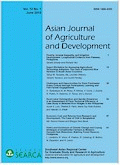Economic growth in rural areas has to align with preservation of land uses that optimise environmental services. This means that trade-offs between economic and ecological priorities need to be understood, quantified and managed. We aimed to estimate the trade-off in the Tanjung Jabung Barat district of Jambi province Indonesia, where traditional agroforestry systems on both peat and mineral soils and logged-over forests give way to monocultural plantations of pulpwood and oil palm (Elaeis guineensis). Simulations of a 30-year time period of four scenarios using the FALLOW (Forests, Agroforests, Low-value-Landscape, Or, Wastelands) model show that a business-as-usual scenario of economic growth unhindered by the application of conservation scenarios will lead to high carbon dioxide CO2 emissions. The forest and agroforest protection scenario, with moderate assumptions for peat-based emissions, had opportunity costs of 3-100 USD/t CO2e. This occurred especially when the establishment of oil palm plantations, which are currently the most profitable land use option in the area, is directed solely to under utilized mineral soils. The high trade-off values are difficult to reconcile when relying only on C trading mechanism to offset economic opportunity costs of not converting forests and/or agroforests to plantations. We conclude that law-based protection of existing forests, investment in intermediate intensity agroforestry options that utilize locally adapted trees and do not require drainage of peatlands, and re-introduction of tapping Jelutung (Dyera sp) latex as non-timber peat forest product, are needed in the Tanjabar district to provide options that are sustainable from both ecological and economic perspectives.
DOI:
https://doi.org/10.1007/s11027-013-9485-8
Altmetric score:
Dimensions Citation Count:
























